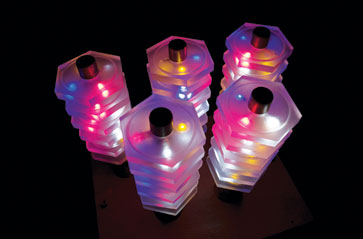Dark matter music
The search for dark matter strikes a new note with a multimedia art work that turns data from an underground experiment into colored light and musical tones.
 |
| Photos: Reidar Hahn, Fermilab |
Karl Ramberg's creations often blend sound and visuals; one of his most recent works, for example, combined art made from musical scores with the music they contained. But a trip with his brother, Fermilab physicist Erik Ramberg, took his work in a more scientific direction.
Their destination was a mine in Soudan, Minnesota, where Erik was scheduled to work in the control room of the Cryogenic Dark Matter Search experiment.
"The whole notion of being at the bottom of an abandoned iron mine—there is something kind of romantic or mysterious about it," Karl says.
The Cryogenic Dark Matter Search detects particles such as neutrons, electrons, and cosmic rays that rain in from space. It hasn't recorded any dark matter particles yet, but scientists are hopeful.
After spending the better part of a week in the mine, Karl built a full-scale plastic model of the detector with the help of his brother and CDMS collaborator Prisca Cushman, a physics professor at the University of Minnesota, who translated the data into light and sound.
"I spent a lot of time programming it," Cushman says. "I had to get CDMS files in the proper format and figure out what sounds good." Her neighbor's 10-year-old nephew helped film the musical model and post it on YouTube.
Cushman translated the energy of each incoming particle into a musical note, and the point where it struck the detector into color. In addition, each type of particle got a unique instrumental voice. Midway through the performance, Cushman had the model play the familiar six-note melody from Close Encounters of the Third Kind and a snippet of "When You Wish Upon a Star." ("That is a little joke," she confesses in the comments following the video clip. "I couldn't help myself.")
The end result, Karl says, is that "you get an experience, aurally and visually, of subatomic effects. You get a better understanding of what the data is saying."
Cushman says she and the Rambergs would eventually like to display the model, or one just like it, at a science or university museum.
"This could be a great outreach tool," Cushman says. "It has a lot of potential to spark people's interest."
Rhianna Wisniewski






